EQUIPMENT TEST REPORTS: Hirsch-Houck Laboratory test results on the: Pioneer SA -9900 integrated stereo amplifier, Pickering XUV/4500Z stereo/CD-4 phono cartridge, Wollensak 4766 stereo cassette deck, and Tannoy Micro TM55DD record player. By JULIAN D. HIRSCH
Pioneer SA-9900 Integrated Stereo Amplifier
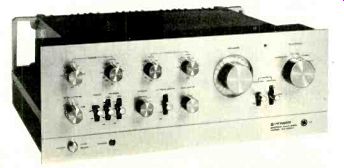
PIONEER'S finest integrated stereo amplifier, the SA-9900, is rated to deliver 110 watts per channel continuously between 20 and 20,000 Hz into 8-ohm loads with no more than 0.1 percent total harmonic distortion (THD). It combines many of the features of earlier Pioneer amplifiers with several new ones to provide exceptional operating flexibility and electrical performance.
The dual tone-control system found on some other Pioneer products is part of the SA-9900. There are two bass controls and two treble controls, calibrated to show their effect on the output at frequencies of 50, 100, 10,000, and 20,000 Hz. They are step-type controls, the lowest and highest having a range of ±4.5 dB and the others having a range of ±7.5 dB, all in 1.5-dB steps. Lever switches bypass all tone-control circuits and introduce low- and high-frequency filters with cut-off frequencies of 15, 30, 8,000, and 12,000 Hz.

-------- FREQUENCY IN HZ (CYCLES PER SECOND; CONTINUOUS
AND EQUIVALENT SINE-WAVE WATTS/CHANNEL

---------- The right and left side panels of the Pioneer
SA-9900 incorporate a section that provides a convenient mounting surface
for the profusion of input and output terminals. Two switches above
the phono-input jacks select phono-input load impedance and phono or
mic level.
The SPEAKERS switch connects either or both of two pairs of speakers or shuts them off for headphone listening via the front-panel jack. The MODE switch provides normal or reversed STEREO, MONO (L R), and either right or left inputs through both amplifier out puts. As the BALANCE control decreases the output of one channel, the level of the other increases by as much as 6 dB (most balance-control systems maintain a constant level on one channel as the other is reduced).
A large FUNCTION knob selects the pro gram source. Inputs are provided for PHONO I, MIC/PHONO 2 (plugging a microphone into the front-panel jack disconnects the phono source), TUNER, AUX I, and AUX 2. The volume control is a detented twenty-two-position selector that operates with a positive yet light "feel." Volume is reduced in 2-dB steps to-30 dB, and in larger steps to-60 dB, followed by a fully OFF position. The level markings are set slightly behind the panel surface and are rather faintly illuminated by edge lighting. A small orange light indicates that the amplifier is on.
A three-position lever switch labeled ATTENUATOR makes it possible to operate the volume control in a convenient portion of its rotation over a wide range of input levels. It has fixed steps of 15 and 30 dB. The other front-panel controls include two lever switches, one connecting the amplifier for off-the-tape monitoring from either of two tape decks and the other connecting the recorders to copy a tape from either one to the other. Power is controlled by a pushbutton switch.
Unlike most amplifiers, the rear of the Pioneer SA-9900 is fully occupied by a large heat sink. The various inputs and outputs are located along the sides of the unit, with guides (which resemble handles, but are not intended as such) to dress the cables out to the rear. On the left side are three a.c. outlets (one of them switched) and insulated connectors for two pairs of speakers. The separate PRE AMP OUT and POWER IN jacks are on this side, with a slide switch to open the internal jumpers for connecting accessories (such as electronic-crossover networks or equalizers) between the preamplifier and power amplifier sections.
The right side of the amplifier contains the input and output jacks. A small knob adjusts the MIC/PHONO 2 sensitivity over a range of 0 to-12 dB relative to the PHONO 1 sensitivity.
A four-position switch adjusts the PHONO 2 input impedance from 35,000 to 100,000 ohms in four steps (PHONO 1 is always 50,000 ohms). The amplifier is supplied with soft plastic covers on all signal and power sockets, and the manual suggests leaving them on all unused connectors (presumably to discourage improper connections at a later time). The Pioneer SA-9900, with its front panel finished in satin gold, is 16 1/2 inches wide, 6 1/2 inches high, and 15 1/4 inches deep; it weighs 44 lbs. Price: $749.95.
Laboratory Measurements. Following a one-hour preconditioning period at 37 watts output, the Pioneer SA-9900 heat sink was warm, but not excessively so. With both channels operating into 8-ohm loads, the outputs clipped at 132 watts per channel at 1,000 Hz.
With 4- and 16-ohm loads, the power levels at clipping were, respectively, 189 and 85.6 watts. The THD with a 1,000-Hz test signal was below the noise level until the output reached 20 watts, where it measured 0.016 percent. It remained under 0.013 percent up to 120 watts, and reached 0.05 percent at 130 watts. The intermodulation distortion (IM) was less than 0.03 percent from 2 to 120 watts, increasing to 0.08 percent at 140 watts. Although the IM rose to 0.32 percent at the extremely low output of 3.5 milliwatts (mW), this does not indicate any significant amount of "crossover" distortion, since distortion was a mere 0.05 percent at 100 mW.
At the rated 110 watts per channel, as well as at half and one-tenth rated power, the THD was under 0.03 percent from 20 to 20,000 Hz (typically under 0.015 percent).
At the AUX inputs, 42 millivolts (mV) drove the amplifier to an output of 10 watts with a signal-to-noise ratio (S/N) of 78 dB. The phono sensitivity was 1.4 mV, with a S/N of about 68 dB and a remarkable overload capability of 500 mV. If PHONO 2 is used at reduced sensitivity, the overload point can be raised to about 1 volt, though this is certainly not required for any hi-fi phono cartridge we know of. The mic-input sensitivity was 1.7 mV, with a S/N of 55.5 dB and a 1.1-volt overload point. Although Pioneer's published S/N figures are somewhat better than our test results, they are based on an output of 110 watts (which adds about 10 dB), on shorted inputs (we use a 2,200-ohm input termination), and on "A" weighting (our measurements are unweighted). When the proper conversion factors are applied, there are no essential contradictions between our figures and Pioneer's published ratings.
The tone-control characteristics were as represented, with our measurements agreeing closely with the indicated level changes. Pioneer's dual tone-control system is one of the most effective we have used, making it possible to reduce mid-bass boom resulting from speaker/room resonance without loss of deep bass response, and to restore the sparkle to the high end of a speaker lacking extreme highs without adding stridency or increasing noise. All the filter characteristics are well chosen, with desirable 12-dB-per-octave slopes.
The RIAA phono equalization was accurate to within ±0.5 dB (about as close as we can measure it) from an extended 30 to 20,000 Hz. Cartridge inductance had only a slight effect on the response at 15,000 Hz and above. The mic signal passes through the phono preamplifier, with an added network to remove the low-frequency RIAA boost, but with no modification of the high-frequency rolloff. As a result, its response is far from flat, although it would be satisfactory for public address use.
The power-amplifier square-wave output had a rise time of about 8 microseconds. Add ing a 2-microfarad capacitor in parallel with the 8-ohm load introduced a single cycle of ringing at about 70 kHz. In testing the amplifier we encountered some problems with "ground loops" due to common ground circuits between the signal generator and the output-measuring instruments. But there was no evidence of this effect when the amplifier was connected as part of a functioning sys tem rather than in a test-instrument setup.
Comment. The output transistors are protected against damage from overload and short circuits by a combination of electronic circuits and a fast-acting relay. Any condition that might prove hazardous to the amplifier (or to any speaker rated to handle its power) causes the relay to disconnect the output instantly with a barely audible click. In a few seconds, normal operation is restored automatically. We deliberately presented the amplifier with every problem it was likely to en counter, and the protective system never failed to do its job.
Aside from these generally objective matters, we must say we were impressed by the care that has gone into the "tactile" characteristics of this amplifier. No matter how well a product performs, sloppy or stiffly operating controls can detract from the pleasure of its use. Pioneer products have long been among the smoothest-handling hi-fi components, but in the SA-9900 they seem to have outdone themselves. Every control operates with a definite positioning, without a trace of loose ness or wobble, and yet requires only a mini mum of effort from the user.
To us, the Pioneer SA-9900 represents the highest current state of development of integrated amplifiers. In all major respects power output, distortion, noise, freedom from phono overload, control flexibility, and styling--it cannot be faulted. It is a beautiful, albeit expensive, product.
==============
Pickering XUV/4500Q Stereo/CD-4 Phono Cartridge
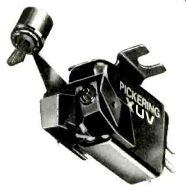
PICKERING describes the new XUV/ 4500Q as a "second generation discrete phono cartridge." This is to distinguish it from almost all previous CD-4 cartridges, which have required relatively high tracking forces (usually 1.5 to 2 grams) and which generally were not able to play the highest velocities on stereo discs without mistracking.
The XUV/4500Q is rated for use at a 1-gram vertical force and to have the 50-kHz frequency response and channel separation needed to deliver full performance from CD-4 records. Virtually all CD-4 cartridges have some form of specially shaped stylus, with a very small "scanning" radius to follow the groove modulation and a much larger trans verse "bearing" radius to distribute the tracking force over a greater area and thus reduce record wear. Pickering calls theirs a "Quadrahedral" stylus, and as with that company's other cartridges, the replaceable stylus assembly carries a hinged brush that removes surface dust from the record.
The internal coils of the Pickering XUV/4500Q have less inductance than those of most stereo cartridges, but it is still recommended that the total cable capacitance not exceed 100 picofarads (pF) to maintain full output to 50,000 Hz. However, the load is quite noncritical for stereo applications, and a typical termination of 47,000 ohms and 275 pF has no effect on the response in the audio range. Price: $139.95.
Laboratory Measurements. The Pickering XUV/4500Q was installed in the tone arm of a Garrard Zero 100 record player which had a total cable capacitance of 100 pF. The initial checks made to determine the tracking force needed to play high-velocity test records confirmed that the XUV/4500Q is on a par with the best stereo cartridges in this respect. The 30-centimeters-per-second (cm/sec), 1,000-Hz bands of the Fairchild 101 test record were played with insignificant distortion at only 0.5 gram-a figure that ranks it with the best of the stereo cartridges we have tested. A tracking force of I gram sufficed for the 32-Hz portion of the Cook 60 record, and at that force the 300-Hz tones of the German High-Fidelity Institute test record could be played at the 80-micrometer level without mistracking. Only a couple of the best stereo cart ridges have done as well in our tests, and the XUV/4500Q matched the best of those by playing the maximum 100-micrometer level with a 1.5-gram force (its maximum rating).
We used a 1-gram tracking force for all sub sequent tests.
Although most CD-4 cartridges have a rather low output voltage (2 to 2.5 millivolts is typical at the reference test velocity of 3.54 cm/sec), the X U V/4500Q delivered a healthy 3.95 mV. Furthermore, the output was identical on both channels (there is a I.5-dB channel-balance spec, but our test cartridge was much better than that). The intermodulation (IM) distortion with the Shure TTR-102 test disc was about 1.5 percent at most velocities, reaching 2.5 percent at the maximum level of 27.1 cm/sec. This is a noteworthy achievement for any cartridge, let alone a CD-4 mod el operating at I gram. The high-frequency tracking distortion, from the 10.8-kHz tone bursts of the Shure TTR-I03 record, was also low up to the 30-cm/sec maximum of the record. The square-wave response showed a single cycle of overshoot and bounce at about 10,000 Hz. The low-frequency tone-arm/ cartridge resonance was at 5 and 6.5 Hz (a double-peaked response), with a relatively low amplitude of about 4 dB.
The frequency response in the audio range was measured with the CBS STR 100 record.
It yielded an output flatness of ±2 dB and a channel separation of typically 20 to 30 dB over the full 40- to 20,000-Hz range. The CD-4 response was checked with the JVC TRS 1005 record from Ito 50 kHz: it produced an output that was flat within ±1.5 dB on one channel and ±3 dB on the other over that en tire range. Channel separation was also fully maintained throughout, typically measuring 20 to 30 dB in the audio band and also in the 20 to 50 kHz carrier band: its minimum of 15 to 20 dB occurred at about 10 to 12 kHz.
When we changed the cartridge load from the CD-4 values to a more conventional stereo load of 47,000 ohms and 335 pF, there was no measurable change in frequency response up to 20,000 Hz, thus confirming fully the stereo compatibility of the cartridge.
Comment. For listening tests, we used the cartridge in conjunction with an early Panasonic SE-405H CD-4 demodulator. With all the CD-4 discs at our disposal the sound quality seemed at least as good as we have heard from other pickups (no direct comparisons were made, however). At times, especially with some of the older discs, there was an occasional tendency to audible "break-up," which could sometimes be minimized by in creasing the tracking force to 1.5 grams.
However, we have every reason to believe that this problem is inherent in the specific records used, and possibly in the early-model demodulator they were fed into. At any rate, no other cartridge we have used has done any better on these apparently difficult-to-track musical passages.

---------- FREQUENCY IN Hz (CYCLES PER SECOND); PEAK
VELOCITY IN CM/SEC OF TEST DISC: In the graph at left, the upper curve
represents the smoothed, averaged frequency response of the cartridge's
right and left channels; the distance (calibrated in decibels) between
it and the lower curve represents the separation between the two
channels. The inset oscilloscope photo shows the cartridge's response
to a recorded 1,000-Hz square wave, which gives an indication of resonances
and overall frequency response. At right is the cartridge's response
to the intermodulation-distortion (IM) and 10.8-kHz tone-burst test
bands of the TTR-102 and TTR-103 test records. These high velocities
provide a severe test of a phono cartridge's performance.
As a stereo cartridge, the X U V/4500Q is in a class with the best units we have used. On the Shure ERA111 test record, the two highest levels of the sibilance test and the highest level of musical bells showed signs of mis tracking, as is the case with most cartridges.
Otherwise, the XUV/4500Q sounded clean and unstrained at all times, especially with ordinary commercial records whose levels unlike the test records-have not been de signed to stress any cartridge to its utmost.
The slight rise in output above 10,000 Hz, though not enough to impart any obvious brightness, is an ideal complement to the reduced output shown by many speaker systems in that frequency range and should restore some of the fine edge of the program content often lost in the uppermost octave of the musical scale.
The Pickering XUV/4500Q is obviously one of the best phono cartridges presently available. One would probably not buy such an expensive unit solely for playing stereo records (although its Quadrahedral stylus should produce substantially less record wear at I gram than conventional elliptical or conical styli at the same force). On the other hand, there are few stereo cartridges that can out perform it in any of its individual characteristics, and we know of none that could be said to be a better stereo/CD-4 pickup. For use only with CD-4 records, there are only a couple of cartridges (also quite expensive) that are at all comparable, and here, too, the Pickering offers a very hard-to-beat combination of performance parameters.
===========
Wollensak 4766 Stereo Cassette Deck
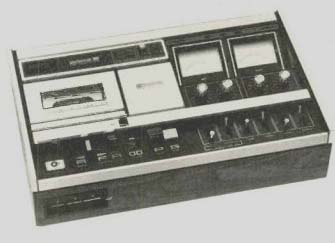
WOLLENSAK'S new Model 4766 cassette deck, using their time-tested, highly regarded transport mechanism, is a deluxe recorder with provision for FM Dolby decoding (during recording or separately). There is switchable bias and equalization for the new Scotch Classic ferri-chrome tape in addition to conventional ferric-oxide and chromium-dioxide tapes.
Screwdriver-adjustable recording-calibration controls make it possible to match the Dolby characteristics to any specific tape formulation. These are factory-set for Scotch Low-Noise/High-Density, Classic, and chromium-dioxide tapes. When the 4766 is used just for decoding of Dolbyized FM broad casts. a front-panel switch shuts off the ma chine's motor and transfers control of incoming signal levels to a pair of screwdriver-slot adjustments in the rear of the machine. Once set for a particular FM tuner's signal-output level (a Dolby test tone transmitted by the station at a 50 percent modulation level should provide a calibration reading of +2 dB on the recorder's meters). the main recording-level controls can be set as required for other recordings without disturbing the special FM calibrations. The 25-microsecond time constant now used for Dolby FM broadcasts is applied automatically by the 4766.
The tape transport used in the Wollensak machine needs little introduction to audiophiles. Since its first appearance several years ago, this basic mechanism has earned a reputation for high performance, ruggedness, and reliability in a number of recorders made by Wollensak and several other manufacturers. The operating controls, for PLAY, STOP, RECORD, and PAUSE, are clearly distinguished by their placement, shape, and direction of motion in use to eliminate any possibility of confusing their functions. A separate FAST WIND lever, when shifted to either side of its center OFF position, moves the tape at very high speed (much faster than most cassette mechanisms) in the indicated (backward or forward) direction.
Six toggle switches along the front of the panel control the FM DOLBY, REC/PLAY DOL BY. TAPE bias and equalization, MONO/STEREO recording mode, recording INPUT (for LINE, MIC, or a mix of the two), and POWER. An EJECT lever raises the cassette-well cover and partially ejects the cassette, and a small panel section can be removed to expose the heads fully for cleaning or alignment.
Along the back of the panel, behind the cassette, are the pushbutton-reset index counter plus signal lights to show when the tape selector is set for ferri-chrome or chromium-dioxide tapes and whether the Dolby system is turned on. And adjacent pushbutton injects a standard Dolby-level tone into the recording circuits for calibrating the Dolby system.
At the right rear are two large illuminated level meters, slightly angled for easier viewing. Above each meter is a red PEAK light that flashes when momentary signal levels exceed 0 dB, and between them is a red RECORD light.
In front of the meters are four knobs for independent adjustment of recording and play back levels on both channels. The line inputs and outputs are recessed into the rear of the recorder's wood base, and a similar recess in the front contains the two microphone jacks and a stereo headphone jack. The Wollensak 4766 is 17 1/4 inches wide, 10 1/4 inches deep, and 6 1/2 inches high, including the smoky-plastic cover supplied with it. The recorder weighs 16 pounds. Price: $429.95.
Laboratory Measurements. The Wol lensak 4766 was tested with the three tape formulations for which it was factory adjust ed: Scotch LN/HD, Classic, and Chrome. The input sensitivity for a 0-dB recording level was 47 millivolts (mV) for LINE and 0.13 mV for microphone (mic) inputs, with the &tic input overloading at a rather low 12.5 mV.
This suggests that to prevent overload a low-output microphone or an external attenuator had best be used when making live recordings of loud sounds. In the mix mode, the gains were reduced by about 3 dB. The relative levels of the line and microphone sources must be set externally, since the recording-level controls affect both inputs simultaneously.
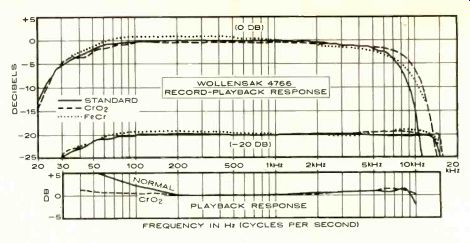
-------- FREQUENCY IN Hz (CYCLES PER SECOND)
The maximum playback level from a 0-dB recording level was 1 volt with LN/HD tape, 0.9 volt with Chrome, and 0.77 volt with Classic. The PEAK overload-indicator lights began to glow at +1 dB, with the brightness increasing at higher levels.
With a 1,000-Hz signal recorded at 0 dB, playback distortion was 2.3 to 2.7 percent, depending on the tape used. The reference harmonic-distortion level of 3 percent was reached at +2 dI3 with LN/HD, +1 dB with Classic, and +0.5 dB with chromium-dioxide tape. Signal-to-noise ratios of the three tapes (with IEC "A" weighting) were, respectively, 53.8, 54.2, and 55 dB referred to the 3 percent distortion level. With the Dolby system switched in, these figures improved to 62, 60, and 61.5 dB. Through the mic inputs, at maxi mum gain, the noise increased by 12.5 dB, but at normal gain settings the added noise was not significant.
The transport of our test sample ran about 1 percent fast. A C-60 cassette was fast for warded and rewound in 45 seconds. Wow was literally unmeasurable (0.01 to 0.35 percent), and the unweighted r.m.s. flutter was about 0.14 percent--similar to our test results with other decks using this transport.
We measured the playback frequency response with a Nortronics AT-200 test tape for the 120-microsecond "standard" playback equalization, and a Teac 1 16SP tape for the 70-microsecond equalization used with chromium-dioxide and ferri-chrome tapes. The latter was virtually flat within ±0.5 dB from 40 to 10,000 Hz, while the former was within ±2 dB from 100 to 10,000 Hz and rose at lower frequencies to +6.5 dB at 31.5 Hz. Like that of many recent recorders, the 4766's play back equalization at 50 Hz does not conform to the curve of the Nortronics tape, which accounts for the apparent bass rise.
The record-playback frequency response was unusually flat over the full audio range at a -20-dB recording level. With the Scotch LN/HD tape it was within ±-0.5 dB from 60 to 13,000 Hz and it was down 3 dB at 37 and 14,500 Hz. At a 0-dB level, the usual high-frequency roll-off occurred because of tape saturation, with the two curves intersecting at 10,500 Hz. The Classic tape response was ± 1 dB from 50 to 14,500 Hz, down 3 dB at 37 and 15,000 Hz. Its 0- and-20-dB curves intersected at 14,000 Hz, indicating its superior high-frequency capability. Finally, the chromium-dioxide tape produced the widest response at-20 dB-within ±0.5 dB from 70 to 15,000 Hz, and down 3 dB at 35 and 15,400 Hz. Its 0- and-20-dB curves intersected at 13,400 Hz, placing it about halfway between the ferric-oxide and ferri-chrome tapes in this respect.
The meters read +2 dB (their Dolby calibration level) when we played a 200-nanowebers-per-meter Dolby-level tape. Their ballistic response was very close to that of a true VU meter, with 0.3-second tone bursts reading at about 95 percent of their steady-state indication.
Comment. Having had experience with the Wollensak transport in 3M and other machines over a number of years, we felt completely at home with the 4766. Although it may lack the glamour and feather-touch pushbuttons of a solenoid-operated mechanism, the Wollensak transport has what we consider to be some of the best human engineering in this field, as well as being one of the most time-tested designs in current cassette-recorder manufacture.
The only disconcerting note was the fact that when the fast-speed lever was used it remained in either operating position rather than being spring-loaded to return to its center "off- position when released. Since the automatic end-of-tape shutoff and mechanical disengagement do not function in the fast-winding modes, one must still stand by to shut off the machine when the tape stops. Also, in view of the very fast winding speed of the Wollensak mechanism, we have never considered the need to hold the lever (in the original design) a hardship, but perhaps others have.
The headphone output of the 4766, which is intended to drive 8-ohm phones, is one of the very few we have encountered that can also deliver a strong and listenable volume with high-impedance (200-ohm) phones. The PEAK lights are a very useful guide to setting safe recording levels, since the tape begins to saturate (overload) just above 0 dB, and one must normally keep the maximum meter readings somewhat below that level. By setting the gain so that the lights just flicker on the highest peaks, one is reasonably sure of having a distortion-free recording with the best possible signal-to-noise ratio.
The FM Dolby feature, which is found on a few other recorders, is a strong "plus" of the 4766 because of the way it is interlocked with the recorder controls. For simply listening to a decoded Dolbyized station, the deck's mo tor is shut off. However, a recording can be made at any time (without going through Dolby decoding) merely by pressing the RECORD and PLAY buttons. In addition, since only a few tuners and receivers have available the 25-microsecond de-emphasis characteristic required for proper FM Dolby decoding for either recording or listening, the inclusion of this feature in the Wollensak 4766 eliminates the need for an external adapter.
There is little one can say about the sound quality of the 4766. It is in every way typical of the finest cassette-deck performance which is to say, very fine indeed. We were somewhat surprised to find that the ferri-chrome tape, even with the presumably optimized circuits of the 4766, did not significantly surpass the chromium-dioxide or low-noise tapes. Perhaps the super-critical recordist will prefer the marginally better high-frequency saturation properties of the Classic tape. For our part, there was little to choose from among the various tapes with respect to the final listening quality. They were all excellent.
As we see it, the Wollensak 4766 is a machine designed to be wired into a good music system, including a non-Dolby FM tuner.
When so used (in contrast to making "live" recordings, for which it is less well suited), it will probably do as many things for as many people as any cassette machine we know of.
Furthermore, it does them about as well as the current state of the cassette art allows, and at a very down-to-earth price.
============
Tannoy/Micro TM55DD Record Player
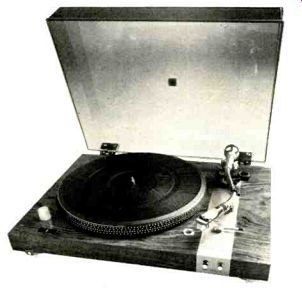
ALTHOUGH the Tannoy name has long been associated with loudspeakers, Tannoy ( America) Ltd. has recently begun to distribute a line of fine record players manufactured in Japan by Micro/Seiki. At the top of the Tannoy/Micro line is the deluxe Model TM55DD, whose Ph-pound cast-aluminum platter is driven directly by the shaft of a ser vo-controlled d.c. motor at either 33 1/3 or 45 rpm. Separate vernier adjustment knobs for each speed, with a nominal ±6 percent range, are located on the front of the base, where they are accessible even with the cover lowered.
The edge of the platter carries four rows of raised stroboscope dots for both speeds and either 50- or 60-Hz power lines. (The turn table speed, of course, is not affected by line frequency, but the neon lamp that provides the stroboscopic illumination of the platter markings is.) The TM55DD is a completely manual record player with no automatic features. Its tone arm is made with jewel-like precision, but it must be placed by hand in the lead-in groove and removed from the run-out groove at the end of the record. The counter weight position is adjusted by rotating it for arm balance; what appears to be the forward section of the weight is then turned to align its zero calibration against a reference mark on the tubular-arm body. Similar systems are used on other arms, but most of them require the main weight to be held in place while making the zero adjustment. In the Micro arm, the two rotating sections of the counterweight, although they appear to be a single unit, are constructed so that the tracking-force scale turns completely independently of the main weight, after which the latter is rotated by its knurled ring, turning both sections to place the desired tracking-force calibration (from 0 to 3 grams, at 0.25 gram intervals) against the reference line.
A dial on a horizontal extension of the pivot support is calibrated from 0 to 3 grams: this supplies the anti-skating correction. The arm-lift bar and its operating lever are also next to the pivot structure, and they provide damped lift and descent of the arm.
The low-mass metal cartridge shell plugs into the end of the arm and is held in place with a locking ring in the manner of many other European and Japanese arms. The finger lift is integral with the sliding cartridge mount, and a plastic jig is supplied for setting the correct stylus overhang. The single operating lever on the motorboard switches the turntable to 45 rpm when moved toward the rear and to 33 1/3 rpm when moved toward the front, the center position being OFF.
The base of the Tannoy/Micro TM55DD is rather large (18 1/2 x 13 1/2 inches) and is handsomely finished in what appears to be rose wood. The tinted, easily removable plastic cover is hinged, and it remains open without additional support. The entire unit is sup ported on four adjustable feet that act as vibration and shock isolators. Each can be screwed out over a range of nearly one inch, so that the turntable can be leveled on almost any mounting surface with the aid of the circular bubble level on the motorboard. The Tannoy/Micro TM55DD is approximately 18 1/2 inches wide. 13 1/2 inches deep, and 6 inches high (with the cover lowered); it weighs 18 pounds. Price: $330.
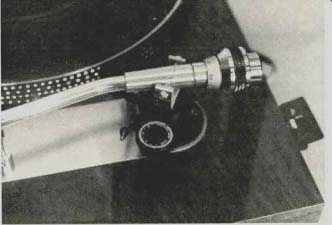
---- The pivot area of the precisely machined tone arm
incorporates the anti-skating adjustment and damped cuing lever.
Laboratory Measurements. We tested the Tannoy/Micro TM55DD with an ADC XLM MKII cartridge installed in its tone arm. The low-frequency resonance was at approximately 10 Hz. Since this cartridge resonates at 8 Hz in a typical good-quality record-changer arm, it is evident that the Micro arm has a relatively low effective mass is spite of its physically large appearance. The tracking-force calibrations were accurate within 0.05 gram over their full range. The anti-skating dial had to be set about 0.5 to I gram higher than the tracking force for optimum correction. The cueing system operated smoothly, with no lateral drift during the arm descent. The tracking error was less than 0.5 degrees per inch over the record's playing surface (between radii of 2.5 and 6 inches). The manufacturer states that the Tannoy/Micro arm was designed to be compatible with CD-4 cartridges, and this was confirmed by the measured wiring and cable capacitance of 95 picofarads per channel.
The turntable reached its synchronous speed in about 4 seconds at 33 1/3 rpm. The vernier speed adjustments had a range of +7.2 to-5.2 percent at 33 1/3 rpm, and from +8.6 to-5.8 percent at 45 rpm. A change in line voltage from 95 to 135 volts had absolutely no effect on the operating speed, which also did not shift detectably over long periods of operation. Wow and flutter, as one would expect from a well-engineered direct-drive turntable, were very low. The unweighted rms wow measured 0.035 and 0.045 percent at the 33'/3 and 45-rpm speeds, and the flutter readings were, respectively. 0.035 and 0.03 percent. The unweighted rumble was-35 dB, but since it was concentrated in the sub-sonic frequency range, applying RRLL audibility weighting reduced the figure to a very good
-62 dB.
Comment. The simple statement that the Tannoy/Micro TM55DD easily met or surpassed all its specifications completely fails to convey a sense of the "feel" and of the tasteful styling of the total package. In its technical performance aspects, the TM55DD is certainly the effective equal of the best of today's record players, and (in our view) it is also one of the handsomest pieces of equipment we have seen in some time. Admittedly, styling is a subjective matter, but we could not help being impressed by what appears to be a most successful wedding of form and function.
The adjustable mounting feet of the TM55DD ( a feature most of us tend to ignore in favor of the more publicized aspects of record-player design) are remarkably effective in both of their intended functions. Leveling the base takes a few seconds, and the soft mounts isolate the record player from external vibration with considerable effectiveness. It would be difficult, if not impossible, to induce acoustic feedback with this unit unless it were placed directly on top of a speaker that had powerful bass response. Rough measurements suggest that its isolation from the sup porting surface, in the frequency range from 20 to several hundred hertz, is from 10 to 30 dB better than that of a couple of highly regarded record players we have checked in a similar manner. This new measurement technique has recently been undertaken at H-H Labs in the hope that it will yield quantitative data on the susceptibility of record players to acoustic feedback. As we gain experience with other record players, we expect to have some specific results to report.
To sum up, the Tannoy/Micro TM55DD, although lacking the automatic features of most comparably priced units, nevertheless does offer some very concrete advantages to the user, in addition to being a thoroughly competent and attractive product.
Also see:
SPEAKER PLACEMENT--You cando it yourself because of a nice acoustical reciprocity, ROY ALLISON